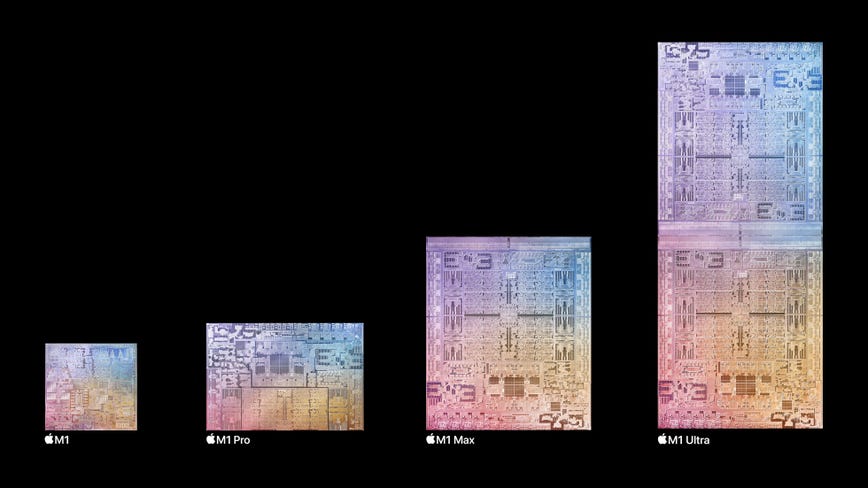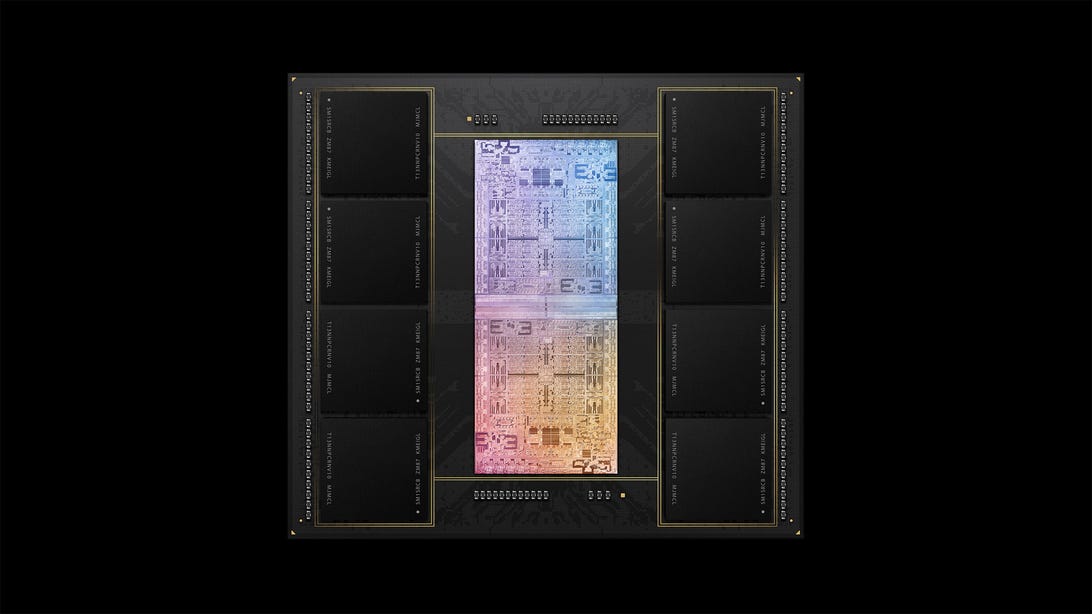M1 Ultra, M1 Pro, M1 Max and M1: Apple Mac Chips Compared

Apple
Announced at?Apple’s “Peek Performance” event this month was another high-powered member of the M1 homegrown chip line, debuting in a shiny new Mac Studio micro desktop system. Along with the rest of the company’s M1 chip line, the?M1, M1 Pro and M1 Max, the new M1 Ultra?once again raises the performance level. It also hints at how Apple can scale its hybrid chip line to accommodate a Mac Pro-level system — the lone remaining Intel-based model — to complete its two-year plan to transition its system processors completely in-house.
Intel introduced its own hybrid (Alder Lake) 12th-gen desktop and mobile chips?in late 2021. Thanks to the myriad possible combinations of performance and efficiency cores, plus GPU cores (execution units), choosing between those chips is nothing less than confusing.
See also
- Mac Studio, iPhone SE and More: Everything Apple Announced
- iPhone SE 2022: Apple’s $429 Phone Gets 5G, A15 Bionic Chip
- Mac Studio, Studio Display: Apple’s New Desktop for Creatives
Since Apple has fewer partners to please — just itself, actually — it doesn’t have Intel’s need to produce an overwhelming number of variations to allow for desktop and laptop systems to be priced differently. Still, Apple can be just as confusing because of the distinct CPU and GPU cores in chips that fall under the same name.?
For instance, there are two versions of the M1 Pro, one with eight CPU cores and 14 GPU cores, and another with 10 CPU cores and 16 GPU cores. There are also two versions of the M1 Max.?
The M1 Max and M1 Pro clearly differ in terms of peak performance, with the M1 Max doubling some important contributors to theoretical performance, notably the number of hardware?ProRes?accelerators, which are extremely important for pro video editing. The M1 Max also doubles the bandwidth for some internal interfaces, like that between memory and the processor. Those won’t necessarily “double” the performance delivered in real-world use, though.?
Apple M1 vs. M1 Pro vs. M1 Max vs. M1 Ultra
| Apple M1 | Apple M1 Pro | Apple M1 Max | Apple M1 Ultra | |
|---|---|---|---|---|
| Total CPU cores | 8 | 8 or 10 | 10 | 20 |
| Performance cores | 4 | 6 or 8 | 8 | 16 |
| Efficiency cores | 4 | 2 | 2 | 4 |
| GPU cores | 7 or 8 | 14 or 16 | 24 or 32 | 48 or 64 |
| Neural engine cores | 16 | 16 | 16 | 32 |
| Maximum memory supported (UMA) | 16GB | 32GB | 64GB | 128GB |
| Peak memory bandwidth (GBps) | n/a | 200 | 400 | 800 |
| ProRes accelerators | None | 1 | 2 | 4 |
| Available in | MacBook Air, iPad Pro (5th gen), iMac 24 (2021), Mac Mini | MacBook Pro 14, MacBook Pro 16 (2021) | MacBook Pro 14, MacBook Pro 16 (2021), Mac Studio | Mac Studio |
Apple took a somewhat blunt approach for the M1 Ultra, simply tying together two M1 Max (24 GPU core) processors and chipsets via a 2.5TB/sec direct connection, branded “UltraFusion,” rather than having to traverse the slower system bus. So it has two of everything, such as two Thunderbolt controllers and two memory controllers. That’s why the Mac Studio with the M1 Ultra has more Thunderbolt ports and can accommodate twice the memory of its M1 Max-based counterpart. It’s basically a dual-processor system. There are even two versions for both GPU variations of the M1 Max.

The Ultra is two processors and two chipsets tied together.
Apple
And that’s likely to make it bigger and hotter. For instance, the chip is easier to scale to larger numbers of CPU and GPU cores, which will be necessary for whatever Mac Pro refresh is in the cards, but it seems cumbersome to have multiple supporting chipsets as well. The Mac Studio with the M1 Ultra has a huge heatsink and fan system necessary to cool it. Though it likely doesn’t deliver twice the performance of the M1 Max, we still don’t know how performance scales with the number of processors. This will be its first test.
One thing about the M1 implementations thus far is that there is no mention of discrete graphics support. Apple has claimed the Ultra delivers better graphics performance than the AMD cards in the Mac Pro, possibly teeing up a future reveal that it won’t have any — or that it has created a discrete graphics solution based on its GPU technology. Unlike the Mac Studio, which can’t be upgraded, the Mac Pro has to be upgradable. That’s one of the points of it.
Keep in mind that Apple’s unified memory architecture means that memory is shared by the GPU and CPU. That’s definitely better for performance, since it makes both processing and graphics tasks faster at passing data between each other.?